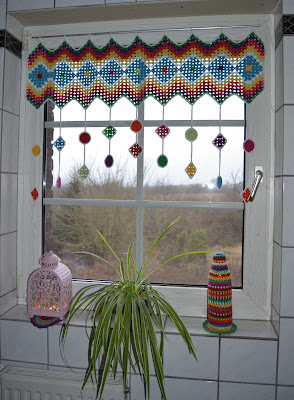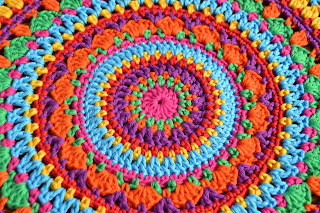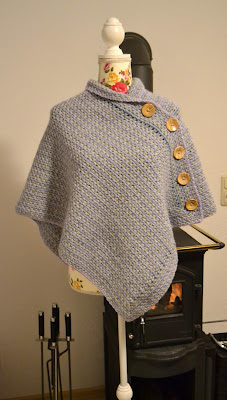Eifel-Wool / Eifel-Wolle
Dear friends,
more than a year ago Jenny Neuhaus gave me ten kilos of fleece from her sheep. I sent the wool on to Jahnsdorf in Saxony, to the mill of Conny Böhme and now it is back, washed, carded, spun and caked into cute scrumptious balls...
How did that come
about?
Well, after I started dyeing wool, I became more interested in
the product (wool) itself and whether I could buy it locally. You can
probably guess the answer: no!
 |
| @ Jenny Neuhaus |
So I wondered what
happened with the wool of the local sheep (and there are plenty of
sheep in the Eifel). As I started to ask around, I met with
incomprehension at first, because wool has lost it‘s value (aka why
am I interested?).
Wool being worthless seems to be the common opinion here in Germany and in the Eifel. Wool is burned, ploughed in, sometimes it‘s used as insulation material or in the carpet industry. Shearing costs the shepherds more than the wool pays for. Wool has become a by-product, an annoying appendage.
Wool being worthless seems to be the common opinion here in Germany and in the Eifel. Wool is burned, ploughed in, sometimes it‘s used as insulation material or in the carpet industry. Shearing costs the shepherds more than the wool pays for. Wool has become a by-product, an annoying appendage.
 |
| @ Jenny Neuhaus |
This made my
hair stand on end! But not just mine, also the hair of many
shepherds, such as Jenny Neuhaus. Jenny and her husband Tom run the
Eschenhof in Bad Münstereifel. During my research here in the nearer
surroundings I stubled across them. My husband and I
spontaneously drove by on a Saturday morning in spring 2018 and we
met Jenny and Tom (as well as Anna, Frida, Heidi, Maya, Rita, Sandra,
Bambi, Bibi, Antonia, Henriette, Luise, Martha, Marlene and Franzi).
I was delighted when Jenny reacted positively to my interest, my
project and my request for wool. After the shearing in June, I was
able to pick up ten kilos of fleece.
 |
| @ Jenny Neuhaus |
As mentioned before I sent the wool to Saxony, to the fibre mill "Nafabo" of Conny Böhme. In Germany there are only a handful of mills left. Therefore Ms Böhme is pretty busy and I had to wait quite a bit until she was able to process the fleece. But believe me, it was worth waiting for these 46 adorable balls of wool, which are now in turn waiting to be processed (aka dyed) by me.
 |
| @ Conny Böhme |
By the way, Conny
Böhme does not only process the wool of most sheep breeds, but also
llama, yak and even dog hairs. You’ll get more info on the site of
the mill. You can get a glimpse of the 14 steps it takes to turn raw
wool into balls here. It’s a TV report of KabelJournal from October
2018 and it was recorded in Conny Böhme’s fibre mill.
 |
| @ Conny Böhme |
But why all this effort?
Wool is a natural product like no other, a renewable raw material with many advantages and abilities. I listed a few here*:
- wool is a natural thermoregulator. I.e. in winter it protects against cold, in summer against overheating. Wool consists of 85% air and is therefore an excellent insulator.
- wool is also less susceptible to dirt and odours. This means that shaking out and airing is usually sufficient instead of washing.
- wool is breathable, i.e. supports skin respiration. This means that wool absorbs the moisture produced by the skin and wicks it away to the outside.
- wool is crease-resistant thanks to the high elasticity of the wool fibres.
- wool does not become electrostatically charged. Wool always contains a certain amount of moisture, which prevents electrostatic charging.
- and wool is flame resistant.
Granted, the Eifel Wool is not silkily soft. It is wool of milk sheep and their fleece is between 28 and 30 microns. Thus it may not be perfect for wearing near the skin, but will be great for sweaters, jackets, vests, and/or as cuddly pillows or even as a blanket (by the way, wool becomes softer when worn). Be this at it may, Eifel Wool stands for everything that was important to me:
- Eifel Wool is a
local product
- Eifel Wool is from
happy and content and lovingly cared for sheep (I've seen this with
my very own eyes!)
- I am able to make a
tiny contribution to their keeping and to the revaluation of their
wool.
 |
| @ Jenny Neuhaus |
Oh dear – this
blogpost has become a bit long. Well, the topic was/is very important
to me and I wanted to share my joy about this premiere with you. If
you are interested in purchasing Eifel Wool, keep your eyes open and
ears tuned to this channel! BTW: If you subscribe to my newsletter (subscribe-link below),
you will be the first to know when the Eifel Wool is available in the
Atelier Marie-Lucienne Shop.
I’ll keep in touch!
I’ll keep in touch!
Liebe Freunde,
Über ein Jahr ist es nun her, dass ich
von Jenny Neuhaus 10 Kilo Wolle von ihren Schafen bekam. Ich schickte
sie weiter nach Jahnsdorf in Sachsen, zur Naturfasermühle von Conny
Böhme und jetzt ist die Wolle zurück, gewaschen, kardiert,
gesponnen und zu herzallerliebste Knäuel gewickelt...
Wie kam es dazu?
Nun, nachdem ich anfing
Wolle selbst zu färben und mich mehr für das Produkt Wolle
interessierte, wunderte ich mich, wo die Wolle der hiesigen Schafen
hinkommt. Es gibt Schafe zuhauf hier in der Eifel, aber deren Wolle
gibt es nirgends. Als ich vorsichtig hier und da mal nachhörte,
erntete ich im Großen und Ganzen Unverständnis ob mein Interesse,
denn Wolle ist nichts mehr wert.
 |
| @ Jenny Neuhaus |
Wenigstens scheint das hier in
Deutschland und in der Eifel der gängigen Meinung zu sein. Wolle
wird verbrannt, untergegraben, höchstens als Dämmstoff oder in der
Teppichindustrie verwendet. Sie Schur kostet dem Schäfer mehr, als
die Wolle einbringt. Wolle ist zum Nebenprodukt geworden, zum
lästigen Anhängsel.
 |
| @ Jenny Neuhaus |
Mir sträubten sich die Nackenhaare! Aber
nicht nur meine, auch die von vielen Schäfer/innen, wie zum Beispiel
Jenny Neuhaus.
Jenny und Ihr Mann Tom betreiben den
Eschenhof in Bad Münstereifel. Während meinen Nachforschungen hier
in der näheren Umgebung stieß ich auf den Eschenhof. Mein Mann und
ich fuhren an einem Samstagvormittag im Frühjahr 2018 spontan hin
und lernten Jenny und Tom kennen (und nebenbei auch Anna, Frida,
Heidi, Maya, Rita, Sandra, Bambi, Bibi, Antonia, Henriette, Luise,
Martha, Marlene und Franzi). Ich war hocherfreut, als Jenny positiv
auf mein Interesse, mein Vorhaben und meine Bitte nach Wolle
reagierte. Nach der kurz darauf folgenden Schur war es dann so weit:
Ich konnte zehn Kilo Vlies abholen.
 |
| @ Conny Böhme |
Wie bereits erwähnt schickte ich die
Wolle nach Sachsen, zur Naturfasermühle „Nafabo“ von Conny
Böhme. In Deutschland gibt es nur noch eine Handvoll Betriebe, denen
man seine Wolle schicken kann. Daher war die Wartezeit bis ich die
Wolle zurückbekam entsprechend lang, aber das Warten hat sich
gelohnt! 46 herzallerliebste Wollknäuel warten nun ihrerseits auf ihre
Weiterverarbeitung (aka Färben).
 |
| @ Conny Böhme |
Conny Böhme verarbeitet übrigens
nicht nur die Wolle von den meisten Schafsrassen, sondern auch Lama,
Yak und sogar Hundehaare. Weitere Informationen gibt es hier, auf der
Seite der Naturfasermühle. Einen Einblick in den 14 Schritten
zählenden Prozess von der Rohwolle bis zum Wollknäuel bekommt ihr
hier. Der Beitrag des KabelJournals aus Oktober 2018 wurde in der
Naturfasermühle von und mit Conny Böhme aufgenommen.
Weshalb aber der ganze Aufwand?
Wolle ist ein Naturprodukt ohne Gleichen,
ein nachwachsender Rohstoff mit vielen Vorteilen und Fähigkeiten.
Ich zähle hier einige auf*:
- Wolle hat eine natürliche Thermoregulations-Eigenschaft. D.h. im Winter schützt sie vor Kälte, im Sommer vor Überhitzung. Wolle besteht zu 85% aus Luft und isoliert daher hervorragend.
- Wolle ist zudem wenig schmutz- und geruchsanfällig. D.h. Ausschütteln und Auslüften reicht in der Regel statt Waschen.
- Wolle ist atmungsaktiv, bzw. begünstigt die Hautatmung. D.h. Wolle nimmt Feuchtigkeit, die bei der Hautatmung entsteht auf und gibt diese nach außen ab.
- Wolle ist knitterarm dank der hohen Spannkraft der Wollfasern.
- Wolle lädt sich nicht elektrostatisch auf. Wolle enthält immer eine bestimmte Menge Feuchtigkeit enthält, welche eine elektrostatische Aufladung verhindert.
- Und Wolle ist schwer entflammbar.
 |
| @ Jenny Neuhaus |
Zugegeben, die Eifelwolle ist nicht
seidenweich. Es handelt sich um die Wolle von Milchschafe und die
Mikronzahl deren Vliese liegt zwischen 28 und 30. Vielleicht nicht
gerade zum auf-die-Haut tragen, aber als Pulli, Jacke, Weste bestens
geeignet, und/oder als kuscheliges Kissen (Wolle wird übrigens vom
Tragen etwas weicher). Aber, es ist ein hiesiges Produkt, von
glücklichen und zufriedenen Schafe (habe ich mit eigenen Augen
gesehen!), und ich bin in der Lage einen winzigen Beitrag zu leisten
für deren Haltung und für die Aufwertung deren Wolle.
 |
| @ Jenny Neuhaus |
Oh jeh – der Beitrag ist etwas lang
geworden. Nun ja, das Thema Wolle liegt mir sehr am Herzen und ich
wollte meine Freude über meine niedlichen Knäuel gerne mit euch
teilen. Solltet ihr Interesse an eines diesen Knäuel haben, dann haltet
die Augen auf! Am Besten ihr tragt euch in meinen Newsletter ein (den Link findest du oben),
dann wisst ihr als erste, wann es die Wolle im Atelier Marie-Lucienne
Shop zu kaufen gibt.
Und... Ich
halte euch auf dem Laufenden!
Linked up at:











This wood seel fantastic, Marjan. I can't wait to see what you make from this. Hugs, my dear friend.
AntwortenLöschenThank you, dear Mia! If only there were more than 24 hours in a day, I would have dyed them all by now...
LöschenQue maravilla poder disponer de lana de oveja local,sobre todo sabiendo que hoy en día se deshecha!! que terrible error y todo por intereses monetarios!
AntwortenLöschenMe encantará ver que vas a tejer con tan preciosa lana!
Besos.
Gracias, dear Pilar. Tienes toda la razón, todo es cuestión de dinero y eso es una verdadera lástima. Y aunque sabemos que no es así, preferimos comprar la lana más barata de ovejas mal cuidadas (quizás porque es un poco más suave) en lugar de apoyar a los pastores locales.
LöschenVery interesting to read about the wool and how you have all those lovely balls of white wool to work with (or dye). I cannot wear wool because it brings me out in an itchy rash. The only one I can wear is Cashmere which comes from the Pashmina goats. Unfortunately, it's very expensive!
AntwortenLöschen